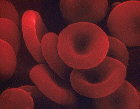Testing for Progesterone Levels in
the Body
Is The Progesterone Cream Being Absorbed
By The Body?
Progesterone cream initially travels through the
body on the body's fatty blood components such as the chylomicrons and red blood cell membranes. As a result, blood
serum level tests for the first 2-3 months will be zero, even though the body is receiving adequate amounts of
progesterone. A saliva test that measures the active component of progesterone will accurately measure progesterone
levels in the body. A saliva progesterone test is inexpensive, convenient and accurate. The saliva test is recommended
by the World Health Organization or WHO.
by Elizabeth Smith, M.D.
The normal way to test for hormone levels is to do a blood test. The test must measure the biologically "free" form of the hormone. Some blood tests do not measure the "free" form of the hormone.
Hormones made in the body's ovary, fat, and adrenals are "bound" or wrapped in a protein. These proteins are called sex hormone-binding globulin (SHBG) or cortisol-binding globulin (CBG). The portion of the hormone that is bound to the protein does not appreciably affect the body. 1% - 10% of the hormone is NOT bound to the protein. It is the unbound form of the hormone that affects the body and is the important value to pay attention to.
When progesterone is applied to the body
on the skin, it is not coated with protein. It travels on the chylomicrons (microscopic balls of oil that float in your blood)
and on themembranes of the red blood cells. It is not bound with protein. It is quickly found in the saliva within
hours of applying the cream to the skin. However, a blood test will measure the bound portion in the water portion
of the blood. When progesterone is applied to the skin, it dissolves into the oily portion of the blood. Oil and
water do not mix. Thus, a blood test will show no progesterone in the blood after the progesterone skin cream is
applied. It will take 2-3 months of progesterone skin cream use for the progesterone to show up in the blood test.
Many physicians who depend on the blood test for progesterone levels will wrongly conclude that progesterone
skin cream does not work.
travels on the chylomicrons (microscopic balls of oil that float in your blood)
and on themembranes of the red blood cells. It is not bound with protein. It is quickly found in the saliva within
hours of applying the cream to the skin. However, a blood test will measure the bound portion in the water portion
of the blood. When progesterone is applied to the skin, it dissolves into the oily portion of the blood. Oil and
water do not mix. Thus, a blood test will show no progesterone in the blood after the progesterone skin cream is
applied. It will take 2-3 months of progesterone skin cream use for the progesterone to show up in the blood test.
Many physicians who depend on the blood test for progesterone levels will wrongly conclude that progesterone
skin cream does not work.
A saliva progesterone lab test is quick, convenient, inexpensive, accurate. The progesterone measured in the saliva is the active form, not bound. It is the recommended by the World Health Organization (WHO). It can be done at home through a mail order kit for $30. You do not need a prescription. The saliva sample is sent back to the lab through regular mail. The level can usually be done in 7-10 working days. It can test for hormone deficiencies. It will confirm that the hormones that you are taking are being absorbed.
Oral Progesterone versus Skin Cream Progesterone
Progesterone taken orally is absorbed by
the intestines. Blood flows from the intestines and directly goes to the liver through the portal vein system.
It does not go directly to the  body. The liver breaks down 85% to 90% of the oral hormone before it reaches
the body.
body. The liver breaks down 85% to 90% of the oral hormone before it reaches
the body.
In contrast, progesterone applied topically to the skin goes directly into the body, and resides in the oily portion of the blood, the chylomicrons and the red blood cell membranes. Little is metabolized by the liver.
The pharmaceutical companies use both methods of administration. You can look in any PDR, Physician's Desk Reference, and find estrogen pills and estrogen skin patches. Since 85% to 90% of oral estrogen is metabolized by the liver, the oral dose is about 10 times greater than that of the estrogen patch.
Likewise the oral dose of progesterone must be 10 times greater than the skin cream dose.
Dr. Lee believes that skin cream administration is superior to oral dosing of progesterone because:
1) After the oral ingestion, the liver breaks down the progesterone, the breakdown products are floating around in your body. We do not know the effect of the breakdown products on the body.
2) Skin cream progesterone travels in the oily portion of the blood and eventually is incorporated into the body fat. Because it is incorporated into the body fat, progesterone is released to the body in level sustained amounts. It does not create high and lows that sublingual (under the tongue) an oral routes do.
Some doctors believe that the oral route may be better precisely because you can create highs and lows that match the menstrual cycle. However, skin cream can also be varied with the menstrual cycle in amount and timing.
Summary
- Use a saliva test to measure the "active" form of the progesterone in body.
- For the first 2-3 months of progesterone
skin cream use, the plasma or blood levels of progesterone may appear to be zero even though the body is receiving
adequate amounts of progesterone.
ZRT Laboratories will do the test for $30.
1815 NW 169th Pl. Ste 3090
Beaverton, OR 97006
(503) 466-2445


